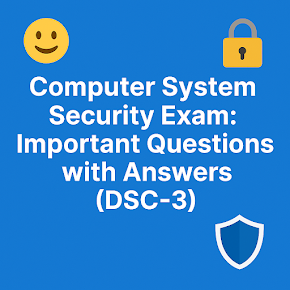Question Paper with Answers 2020-2021
Paper: DSC-3 (Computer System Security)
Full Marks: 80 | Pass Marks: 32 | Time: 3 Hours
Section A: Short Answer Questions
1. Answer the following: (2×5=10 Marks)
(a) What is encryption?
Ans: 🔑 Encryption is the process of converting plaintext into ciphertext using a cryptographic algorithm. It ensures confidentiality by making data unreadable to unauthorized users.
(b) Define symmetric key.
Ans: 🔑 A symmetric key is a cryptographic key that is used for both encryption and decryption of data. It requires secure key exchange between communicating parties.
(c) What is a Trojan Horse?
Ans: 🐴 A Trojan Horse is a type of malicious software that appears legitimate but performs harmful actions, such as stealing data or creating backdoor access.
(d) DES stands for _____. (Fill in the blank)
Ans: 🔐 DES stands for Data Encryption Standard, a symmetric-key algorithm used for securing digital communications.
(e) What is data confidentiality?
Ans: 🛡️ Data confidentiality refers to the protection of data from unauthorized access. It is achieved through encryption and access control mechanisms.
Section B: Conceptual and Analytical Questions
2. (a) What are the key principles of information security? Explain. (4 Marks)
Ans: 🏛️ The core principles of information security are:
-
Confidentiality – Ensures that information is only accessible to authorized users.
-
Integrity – Maintains data accuracy and prevents unauthorized modifications.
-
Availability – Ensures data is accessible when needed by authorized users.
(b) Differentiate between passive attack and active attack. (2 Marks)
Ans:
-
Passive Attack: 👀 The attacker monitors or intercepts data without modifying it (e.g., eavesdropping).
-
Active Attack: 💣 The attacker alters data or disrupts communication (e.g., malware injection).
(c) Define the following: (2×2=4 Marks)
(i) Virus – Ans: 🦠 A self-replicating program that attaches to files and spreads when executed.
(ii) Worm – Ans: 🐛 A standalone malware that spreads across networks without user intervention.
3. (a) What is a transposition cipher? Explain keyless and keyed transposition cipher with an example. (8 Marks)
Ans: 🔄 A transposition cipher rearranges the positions of characters in plaintext without altering them.
-
Keyless Transposition Cipher: Uses a fixed pattern for rearrangement.
-
Keyed Transposition Cipher: Uses a key to define character positions.
Example:
-
Plaintext: HELLO
-
Keyless: OLLEH
-
Keyed (Key = 3124): EHLLO
(b) What is substitution cipher? Explain with an example. (5 Marks)
Ans: 🔤 A substitution cipher replaces each letter with another based on a predefined rule. Example (Caesar Cipher with shift 3):
-
Plaintext: HELLO
-
Ciphertext: KHOOR
(c) What is the difference between monoalphabetic and polyalphabetic cipher? (2 Marks)
Ans:
-
Monoalphabetic Cipher: 🔠 Uses a single substitution rule for all letters (e.g., Caesar Cipher).
-
Polyalphabetic Cipher: 🔢 Uses multiple substitutions, making decryption harder (e.g., Vigenère Cipher).
4. (a) Describe the DES structure. What is double DES and what are its disadvantages? (8 Marks)
Ans: 🔐 DES (Data Encryption Standard) is a block cipher that encrypts 64-bit data blocks using a 56-bit key.
-
Double DES (2DES): 🔄 Encrypts data twice with two different keys.
-
Disadvantages: ❌ Vulnerable to meet-in-the-middle attacks and computational inefficiency.
(b) What is brute force attack? (4 Marks)
Ans: 🛠️ A brute force attack attempts to decrypt encrypted data by systematically trying all possible keys. Longer keys help mitigate this attack.
(c) Briefly explain the following (any one): (5 Marks)
Ans:
-
(i) Triple DES – 🔒 Uses three DES encryptions for enhanced security.
-
(ii) Differential cryptanalysis – 📊 Analyzes differences in input/output to attack cryptographic algorithms.
5. (a) Explain the RSA algorithm along with its applications. (10 Marks)
Ans: 🔢 RSA is an asymmetric encryption algorithm that uses a public-private key pair for secure communication.
Steps:
-
Choose two large prime numbers, p and q.
-
Compute n = p × q.
-
Compute Euler’s totient function ϕ(n) = (p-1) × (q-1).
-
Select an encryption exponent e such that 1 < e < ϕ(n) and gcd(e, ϕ(n)) = 1.
-
Compute the decryption key d, where (e × d) mod ϕ(n) = 1.
Applications: 💳 Used in secure email, digital signatures, and online transactions.
(b) What are the possible threats for RSA algorithm? (4 Marks)
Ans:
-
Factorization Attack: 🔍 If n is factorized, private keys can be exposed.
-
Side-channel Attacks: 🖥️ Attackers use system behavior (timing, power consumption) to deduce private keys.
6. (a) What is message authentication? How is it different from message integrity? (4 Marks)
Ans:
-
Message Authentication: 🔏 Ensures that the sender is verified and the message is not forged.
-
Message Integrity: 📝 Ensures that the message has not been altered during transmission.
(b) What is digital signature? How is signing and verification done in digital signature? (10 Marks)
Ans: ✍️ A digital signature is a cryptographic technique for verifying the authenticity of digital messages.
Steps:
-
The sender generates a hash of the message.
-
The hash is encrypted using the sender’s private key (digital signature).
-
The receiver decrypts the signature using the sender’s public key.
-
The receiver compares the hash to verify integrity and authenticity.







![2023-2024 Iti Workshop calculation and science MCQ [Latest]](https://blogger.googleusercontent.com/img/b/R29vZ2xl/AVvXsEhGgp3rh9IMpumLZ4PkKjs8U74o_epkhHEcrazTJr6B06xyg56c8J1-qfXlIQhA2Ny2qxgYYtXU67ri4s_t2BmryCcsLUFoECe0Ns6GsqMVS-J6F5OJnw-DV9WZbT2NFKhBy4yBZqOrrkBsGXD0e_1_A0-gXqx1dDK138W5f8HBqEle1kXTBkLMx3N7-w/w72-h72-p-k-no-nu/new.png)

.jpg)

0 Comments
Thanks for visiting! We'd love to hear your thoughts – feel free to comment below.